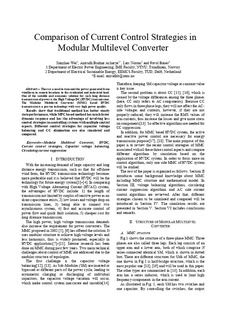Comparison of Current Control Strategies in Modular Multilevel Converter
Chapter
Accepted version

Åpne
Permanent lenke
http://hdl.handle.net/11250/2595062Utgivelsesdato
2018Metadata
Vis full innførselSamlinger
- Institutt for elkraftteknikk [2461]
- Publikasjoner fra CRIStin - NTNU [38015]
Originalversjon
10.23919/IPEC.2018.8507612Sammendrag
There is a need to transmit the power generated from windfarm in remote locations to the residential and industrial load. One of the suitable and economic solution for such long distance transmission of power is the High Voltage DC (HVDC) transmission. The Modular Multilevel Converter (MMC) based HVDC transmission is a proven technology with very high power quality. A multi-objective control is used to control the MMC, one of the objectives is to deliver the power from windfarm to grid, the other objective of the control is to achieve stable operation of the MMC. In order to achieve a stable operation, the capacitors in the MMC should be balanced and the currents circulating within the phases of the MMC need to be controlled. Many control strategies have been proposed to suppress such Circulating Current (CC). However, there is no clear comparison between these control strategies. In this paper control strategies for the MMC are reviewed specifically the circulating current suppressor. The cascaded control based on PI-controller and the Model Predictive Control (MPC) for outer current control are compared. Results show that traditional method has better steady state performance, while MPC based method has much faster dynamic response and has the advantage of involving less control loops in controlling systems with multiple control aspects. The control methods for capacitor voltage balancing and the circulating current suppression are simulated and compared.